
Patrick Anderson’s Exceptional Succulent Garden
I chose classical music for the video because Patrick, in addition to being a succulent expert, is an opera singer.
In my YouTube video, "Patrick Anderson's Succulent Garden," I take you on a tour of the residential garden that launched my love of succulents. You'll see it as it looks now, 25 years after I visited it on assignment for the San Diego Union-Tribune (read the original article, below). Patrick's garden was, and still is, mainly aloes and agaves, plus other succulents and low-water plants.
Visiting Patrick was the first time I had seen a residential garden that featured large aloes and agaves.
He and I became friends, and he graciously proofread the first edition of Designing with Succulents, released---a book that helped generate interest in succulents worldwide, and showed more photos of Patrick's garden than of any other. The book's completely revised second edition includes newer, arguably even better photos of his garden. You'll see some of them in the video.
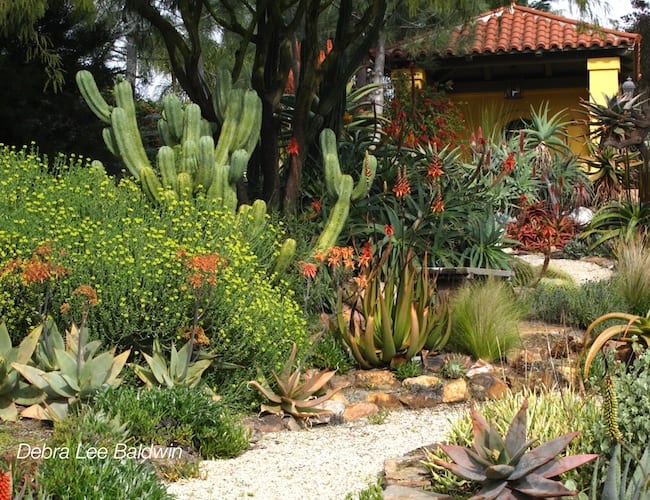
I wonder if Patrick remembers giving me a cutting of that red aloe (A. cameronii, at center right). Photo from the second edition of Designing with Succulents
A dozen great ideas from Patrick's garden:
-- Use low walls and terraces to create an inviting entry garden.
-- Streetside, install a no-irrigation, rock-and-boulder landscape.
-- Create a sense of adventure with curved, meandering pathways.
-- Build an open-air room as a destination and focal point.
-- Repeat a theme color throughout, such as "aloe orange."
-- Contrast the theme color with its complement (i.e., orange with blue).
-- Use large, rounded, unplanted pots as accent pieces.
-- Have your garden double as an outdoor sculpture gallery.
-- Paint walls bold colors to create dramatic backdrops.
-- Make hardscape and walls as visually important as plants.
-- Position barrel cacti so they're backlit by morning or afternoon sun.
-- Create memorable vignettes that express your individual style.
The original article ~ Gardening in the Big Leagues
I'm very proud that this won a prestigious award for newspaper feature writing from the Garden Writers Association of America. ~ Debra
Originally published in the Sunday Homescape section of the San Diego Union-Tribune
Text and photos by Debra Lee Baldwin
Fleshy green monsters in Patrick Anderson's Fallbrook garden look like they might snap him up if he turns his back. They're giant succulents, and Anderson's half-acre hillside showcases hundreds of unusual ones. "I like their huge, sculptural forms," he said during a tour of his garden in January.
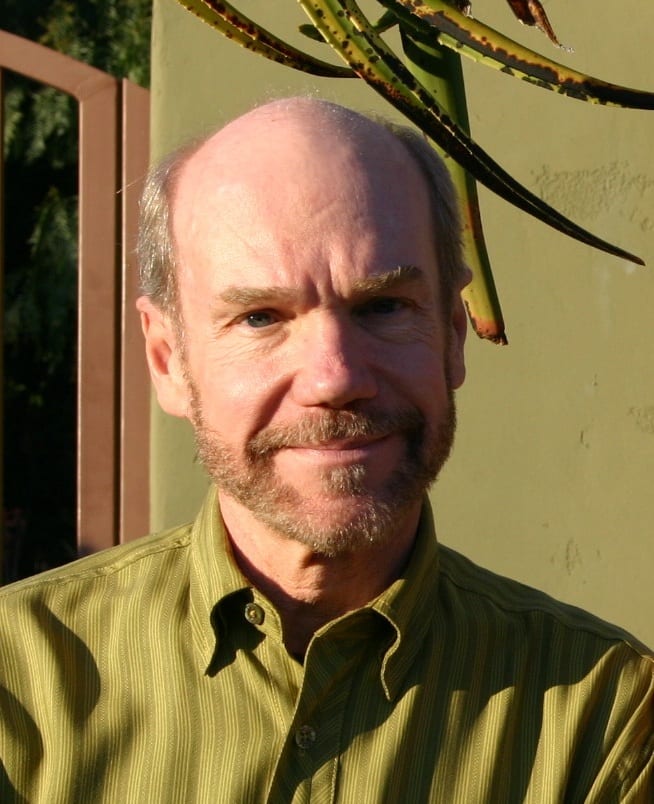 Patrick Anderson
Patrick Anderson
Anderson is an active member of the San Diego Horticultural Society, and is known to local garden clubs as a lecturer who specializes in the great gardens of Europe. "I give slide presentations, and like to think I offer trenchant commentary," Anderson said. "I'm a student of garden history and design, so I put European gardens in that context."
Yet his own garden specializes in plants that wouldn't survive in Europe, much less in most of the U.S. They prefer heat, poor soil and -- because their leaves store water, camel-like -- a dry climate.
Showiest among them are aloes and agaves, giant succulents with an attitude. Punks of the plant world, they produce blooms big as baseball bats, in colors calculated to shock. Hundreds of bullet-sized flowers sheathe bloom stalks. Leaves have sharp tips and clawed edges.
Yet Anderson's armed-and-dangerous flora do have an otherworldly beauty. This time of year, aloes pierce the sky like exotic torch bearers, hot orange against cool blue.
 Aloe ferox and coral tree
Aloe ferox and coral tree
And the way they sprawl like squids or explode upward like fistfuls of knives make them the darlings of architects. Imagine a Volkswagen-sized artichoke growing against a stucco wall: One plant a landscape makes.
Succulents come in all sizes, and grow easily in frost-free areas. They need no fertilizer, and only a little water in summer and fall. They're green year-round, and don't require pruning. Even so, cultivating the behemoths among them is not for the faint of heart.
"I wanted to use desert-climate plants in a lush way," Anderson explained as his footsteps crunched on a gravel pathway near plants aflame with flowers. "And to create a tropical-looking garden that would survive without water."
 A dasylirion's thin, slender leaves suggest spraying water.
A dasylirion's thin, slender leaves suggest spraying water.
Anderson paused at a fountain-shaped Agave americana, commonly known as century plant. Each pointed, tapered leaf was the size of a small shark, and toothed like one, too. Using garden clippers, he snipped a wicked tip that protruded into the pathway.
"With these spines and jagged edges, this is the agave from hell," he said. "But look at its symmetry. Isn't it magnificent?" He continued, "I can't stand it when people cut back an agave so it looks like a pineapple. If you're going to grow something like this, you've got to give it plenty of room. I won't buy a succulent unless it's labeled. I have to know how big it'll get."
Many people confuse agaves with aloes, he added. "Both are succulents and grow in a rosette form, but that's where the similarity ends. Aloes are Old World plants, from South Africa, Madagascar, the Saudi peninsula and the Mediterranean region. Agaves are New World plants from the Americas. Leaves of agaves are fibrous; those of aloes are filled with gel."
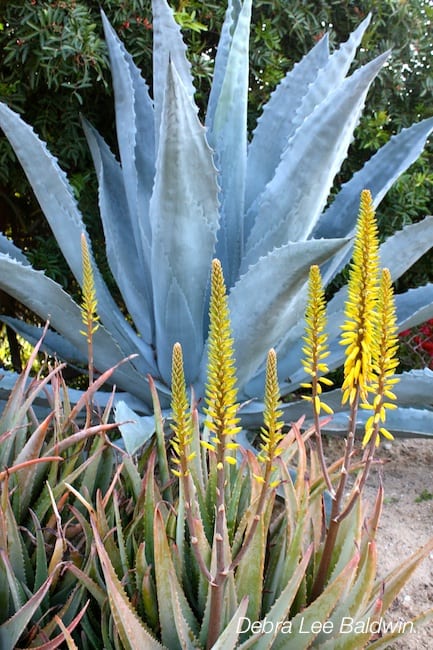 Agave americana and Aloe vera
Agave americana and Aloe vera
He pointed his clippers at a smaller plant topped with yellow blooms. "That's Aloe vera, also known as Aloe barbadensis. It's the best known aloe because of its medicinal uses. And over there, by the lily pond..." he gestured downslope to a succulent supporting a candelabra of coral-orange spires... "is Aloe ferox. It's used in South Africa as a purgative."
"Aloes are in the lily family, yet agaves are the ones that behave like bulbs," he continued. "Agaves send up stems that bloom, and then they die. Aloes don't die after flowering." And, Anderson added with a smile, "an aloe won't kill you if you fall into it."
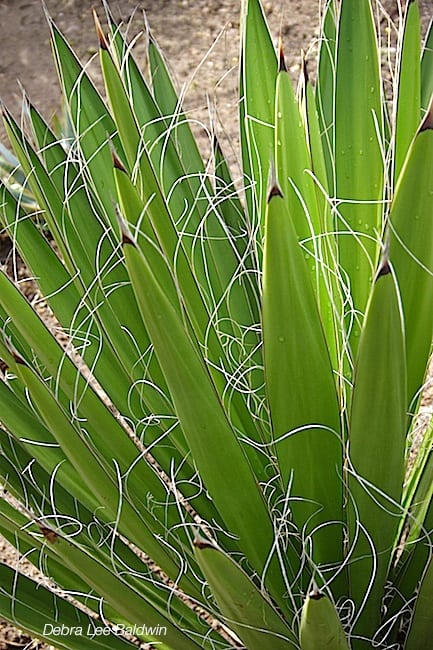 Agave shidigera
Agave shidigera
Anderson's fondness for plants began in childhood. "My grandmother was a wonderful gardener. She had roses and perennials -- the traditional old Irish garden."
He grew up in San Gabriel, and a neighbor who traveled the world gave him cuttings from unusual cacti and succulents. "But I had to leave them behind when we moved to Lake Arrowhead."
Anderson majored in theater arts in college, then worked in the corporate world as a human resources director. In 1988, he and life partner Les Olson transplanted themselves from congested Los Angeles to a two-acre ranch in north San Diego county.
"We didn't move all at once," Anderson explained. "For the first few years, we were here only on weekends." They still maintain a home in Pasadena, enabling Anderson to perform with a choral ensemble in that area (he also sings with San Diego's Pacific Camarata), and to volunteer at the Huntington Botanical Gardens.
Located east of Pasadena in San Marino, "the Huntington" is famous worldwide for a 12-acre dry-habitat garden showcasing more than 5,000 species. National Geographic's "Guide to America's Public Gardens" describes it as "a naturalistic wonderland of often bizarre plants, accenting their architectural shapes and pronounced textures." These attracted Anderson like a moth to a night-blooming cereus, and inspired his own garden.
"I love theater, and these plants are about as theatrical as you can get," he said.
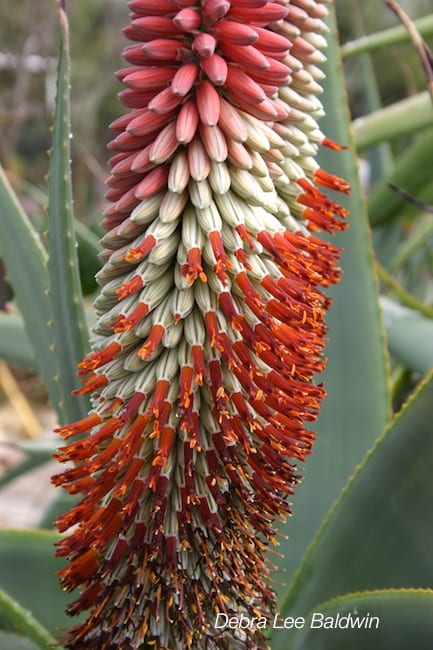 Aloe speciosa
Aloe speciosa
As a Huntington volunteer, Anderson continued, "I work in plant propagation, specifically for plant sales." This entails nurturing seedlings, cuttings, and "pups" taken from the base of parent plants.
Does Anderson have an ulterior motive in step-parenting unusual specimens? You bet.
Half his collection originated at what he calls the "mother of all plant sales," held annually at the Huntington the weekend after Mother's Day. The rest came from "like-minded friends," or nurseries specializing in tropical plants, cactus and/or succulents.
***********
Related info on this site
Aloes: Uses, Photos, IDs & Varieties
Aloes: How To Grow & Varieties All about aloes plus a photo gallery of aloes ID’d and in bloom See All Succulent Types Aeonium Agaves Aloes Cactus Crassula Echeveria Euphorbias Ice Plants Kalanchoe Portulacaria Senecio About Aloes There are dozens of species of Aloe, from tall trees to dwarf cultivars. Aloes typically have juicy, triangular leaves…
See Josh Allen’s Rare Aloe & Cycad Nursery Near San Diego
Josh Allen is making his dream come true: Developing a nursery and botanic garden specializing in rare succulents and cycads. “There’s a big market for beautiful, hard-to-find plants,” he says, adding that creating new hybrids and “playing with plant genetics” are what he does best. He especially enjoys Aloe hybridizing and breeding rare and desirable…


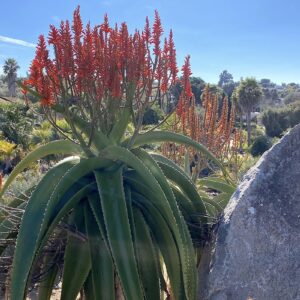
I have been buying my succulents at Cordova nursery in Encinitas but would like to shop at other retail nurseries that focus on succulents in north county that are open to the public.
Thank you for any suggestions,
Rosel
Hi Rose — There’s a list of San Diego Succulent Resources on my website. I think you’ll find it helpful. You’re welcome to download it. — Debra